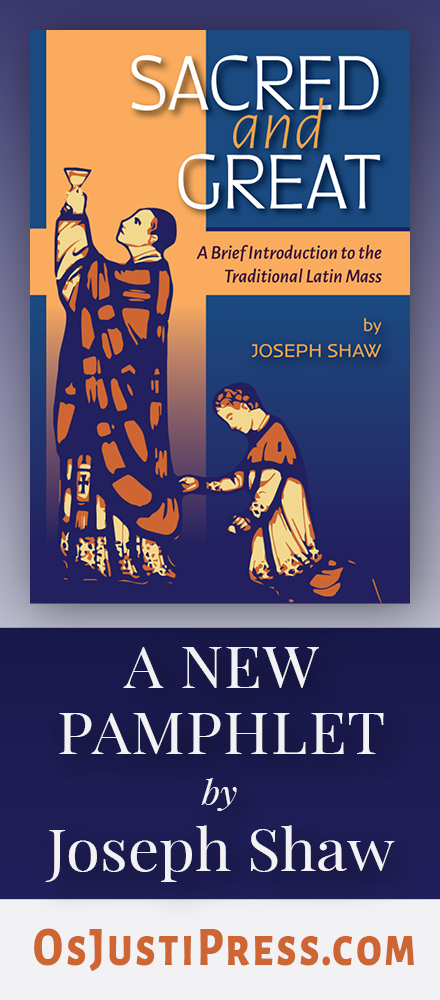NLM readers undoubtedly know by now of the atrocious acts of sacrilege committed against the Most Blessed Sacrament in Pamplona, Spain. This nauseating act of contempt for the most sacred of all sacred things speaks of the decline of the Church in Europe and, broadly speaking, of civilized life more poignantly than anything else could do. There are, thanks be to God, thousands who have been making reparation, as our Lord, never to be defeated and never to be surpassed, draws forth spiritual good from the worst of the devil's attacks. The devil will never win -- but until the end of time, he will never stop trying to mar the good work of God, until he is bound hand and foot and shut up forever.
In connection with this incident, I was struck by an article posted by Dom Mark Kirby, O.S.B., of Silverstream Priory, where he ponders the connection between novel liturgical customs and the kinds of irreverence they make possible today on a scale that beggars the imagination. I shall quote here most of the article, but encourage the readers to go to Vultus Christi for the whole piece (and for other posts -- it is always a most enlightening and edifying blog).
In connection with this incident, I was struck by an article posted by Dom Mark Kirby, O.S.B., of Silverstream Priory, where he ponders the connection between novel liturgical customs and the kinds of irreverence they make possible today on a scale that beggars the imagination. I shall quote here most of the article, but encourage the readers to go to Vultus Christi for the whole piece (and for other posts -- it is always a most enlightening and edifying blog).
A priest friend said to me this morning that bishops the world over need to consider a moratorium on Holy Communion in the hand. Perhaps for the Year of Mercy? Are we to show no mercy to the One who is present among us under the appearances of a thing so fragile as the Host? Do we not recognize in the Sacred Host God become, for love of us, vulnerable, poor, silent, and defenseless? Do we not see that the Sacred Host is the ultimate expression of what Saint Paul (see Philippians 2:7) calls the kenosis of the Son of God, that is His utter self-emptying?
The Instruction Redemptionis Sacramentum promulgated eleven years ago by the Congregation for Divine Worship and the Discipline of the Sacraments 25 March 2004, seems, in most places, to have had little or no effect. One wonders if the clergy were at all given the opportunity to come together to study the document and, with one mind, plan its implementation. Among other things, in article 92, the Instruction says clearly: “If there is a risk of profanation, then Holy Communion should not be given in the hand to the faithful”. Many times I have had Sacred Hosts, sometimes bearing the imprint of shoes after having been trampled, brought to me by aggrieved layfolk who picked them up from the floor of churches. I think it only reasonable to conclude that there is, in fact, widespread risk of profanation. Consequently, article 92 of Redemptionis Sacramentum needs to be invoked and implemented. Not to do so would be, I think, more than a mere oversight.
What has so inured the clergy and laity to the extreme abasement of Jesus Christ in the Sacred Host that sacrileges and profanations meet with no more than a passing measured expression of regret? Have we no mercy for the defenceless Christ? No tears for God? No voice to cry aloud when the Body of God is defiled? One forgets, I think, that the culture of death denounced by Saint John Paul II is, in fact, an attack on the human body. Every attack on the human body and every profanation of the human body is, in the final analysis, an attack on the Body of Christ. Conversely, every attack on the Eucharistic Body of Christ and every profanation of that Sacred Body attacks and profanes the human body. “Amen, I say to you, as long as you did it to the body of one of these my least brethren, you did it to my Body; and as long as you did it to my Body, you did it to the body of one of these my least brethren” (cf. Matthew 25:39). [...]
A society that admits the practice of abortion — dismembering the body of a child — will, ineluctably, feel indifferent towards sins against the Eucharistic Body of Christ, the hóstia pura, hóstia sancta, hóstia immaculáta – the pure Victim, the holy Victim, the spotless Victim. By the same token, irreverence towards the Eucharistic Body of Christ opens the door to every manner of sin against the human body: abortion, pornography, sexual perversion, and every manner of violence and abuse. Everything that affects the body has repercussions upon The Body; and everything that affects The Body has repercussions upon the body.
“The stench of putrefaction”, says the old Italian proverb, “begins from the head of the fish”. I would argue that every loss of reverence at the altar leads to a loss of reverence in the sanctuary; that every loss of reverence in the sanctuary leads to a loss of reverence in the body of the church; that every loss of reverence in the body of the church leads to a loss of reverence in the marketplace, schools, hospitals, and theatres; that every loss of reverence in the marketplace, schools, hospitals, and theatres leads to a loss of reverence in the home; and that every loss of reverence in the home leads to a loss of reverence in the marriage bed.





















